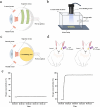The Efficiency and Safety of Oxygen-Supplemented Accelerated Scleral Cross-Linking in Rabbits
- PMID: 40459499
- PMCID: PMC12136097
- DOI: 10.1167/iovs.66.6.10
The Efficiency and Safety of Oxygen-Supplemented Accelerated Scleral Cross-Linking in Rabbits
Abstract
Purpose: The purpose of this study was to evaluate the efficacy and safety of accelerated scleral collagen cross-linking (SXL) with supplemental oxygen.
Methods: The rabbit scleral tissues were randomly divided into seven different SXL protocols, including traditional (T)-SXL (3 mW/cm2 for 30 minutes, 3*30) and accelerated (A)-SXL (30 mW/cm2 for 3, 5, or 8 minutes, respectively, with or without supplemental oxygen). The control group received no ultraviolet-A (UVA) radiation. The tangent modulus of scleral strip was determined by uniaxial tensile test. The protocol with better mechanical property and shorter cross-linking time in vitro was selected for immediate safety assessment using electroretinogram (ERG) in vivo, hematoxylin and eosin (H&E) staining and TUNEL assay in vitro.
Results: The tangent modulus was significantly greater in all SXL groups compared to the control group. The equatorial sclera showed a larger stiffening effect than the posterior. In the equatorial sclera, extending the irradiation time in normoxic A-SXL can result in a further enhancement of the stiffening effect. The tangent modulus was enhanced by 92% in the hyperoxic A-SXL group (30*3) compared with the normoxic A-SXL (30*3) group, and achieved the same mechanical performance as the T-SXL group. The oxygen supplementation did not play a role in further improving he stiffening effect at the posterior sclera. The ERG and H&E staining indicated no abnormalities in the sclera and retina. Apoptosis was only observed in the outer layer of the sclera in the A-SXL groups.
Conclusions: A-SXL protocol of 30 mW/cm2 can improve the mechanical properties of the sclera. In particular, the protocol of 30 mW/cm2 for 3 minutes with supplemental oxygen showed excellent cross-linking efficacy with shorter surgical time and was relatively safe.
Conflict of interest statement
Disclosure:
Figures





References
-
- Zhang X, Jiang J, Kong K, et al. .. Optic neuropathy in high myopia: glaucoma or high myopia or both? Prog Retinal Eye Res. 2024; 99: 101246. - PubMed
-
- Holden BA, Fricke TR, Wilson DA, et al. .. Global prevalence of myopia and high myopia and temporal trends from 2000 through 2050. Ophthalmology. 2016; 123(5): 1036–1042. - PubMed
-
- Steinwender G, Shajari M, Kohnen T. Refractive outcomes after femtosecond laser-assisted cataract surgery in eyes with anterior chamber phakic intraocular lenses. J Refract Surg. 2018; 34(5): 338–342. - PubMed
-
- Wollensak G, Spoerl E. Collagen crosslinking of human and porcine sclera. J Cataract Refract Surg. 2004; 30(3): 689–695. - PubMed
MeSH terms
Substances
LinkOut - more resources
Full Text Sources

